Our high-end cable roundup concludes with cables from Solid Cables, DiMarzio, Mogami, Zaolla, Evidence Elixir and more.
| The Round Up continues! This time we take a look at 11 high-end guitar cables from nine companies, demonstrating designs that move beyond the conventional in the relentless pursuit of tone. Part One did two things for you. First, it presented the basics of cable design, explaining what goes under a cable’s jacket and how design choices can affect sound, handling and durability. Second, rather than covering the vast quantity of basic quality cables that are out there, we connected the theory of cables to practice through our experienced ears and eyes as a long-time guitar player and bass player. For more, listen to our podcast discussing the process of checking out the cables. |
Some Words on Subjectivity For both this article and our previous one, we had to make some choices that would provide you with practical information for future cable decisions. We thought about developing a para-scientific test of some sort – recording each cable and analyzing sound maps, applying extensive rating scales, listening to a comparison of single-coils to humbuckers – all of that.
| High-End Skeptic? Click here for an update to Part One -- we''ve added a cable company who wants you to know that not everyone is buying into the idea that high-priced cables are worth it. |
Finally, we feel it’s important to remind you that we’re not out to pick a winner – at this level, they’re all winners. What’s important is how the sound of a cable fits your needs for a particular situation. The guitar, pickups, and amp you’re using; the sonic mix your playing fits into; and even the acoustics of your musical setting all can favor one cable over another. Change one of those elements and a different cable might make a better choice.
For example, a deeper sounding cable with a warmer top end might be just the thing for one setting, but a cable with a stronger top end, more attack, and less bottom will be what’s called for when you need to change things up. As well, some designers argue that a cable with a wide frequency response lets you have the full sonic palette to work with, shaping the final sound with your guitar and your amp.
How We Compared Cables
The categories of sound, handling, and durability emerged from our first encounters.
Then we took the cables home to listen carefully through gear that would reveal sonic differences among the cables. We kept things constant for each cable – one axe, one amp, one amp setting, one room.
For guitar, Bob used a Tom Anderson Cobra Special-S with Anderson mini-humbuckers plugged into a David Allen "Old Flame" with a Weber 15" Californian speaker. For bass, Dan’s used a passive ’74 Fender Jazz Bass run through an SWR Workingman’s 12" bass combo amp. We tried to set up our gear the way we would for a gig – relatively flat.
Rather than rehashing cable theory at this point, we refer you back to Guitar Cable Roundup, Part One. For now, just keep in mind that different combinations of conductors, shielding and insulators can produce cables of differing volume and frequency response. Likewise, the materials that are chosen can make a cable feel stiffer or more limber. And the way that plugs are attached and protected can affect a cable’s durability.
What we offer here – in addition to an overview of the cable’s construction and our impressions of sound, handling and durability – are comments by cable designers from these companies. We focus on how their design philosophy has translated into an actual cable.
The Cables| Solid Cables Dynamic Arc Ultra |
| About the cable: Braided shielding, aerospace-quality single copper conductor, triple carbon/braid shield, satin nickel diecast Amphenol plugs, tear-resistant protective outer armor. MSRP $135.95 for 12’ cable. |
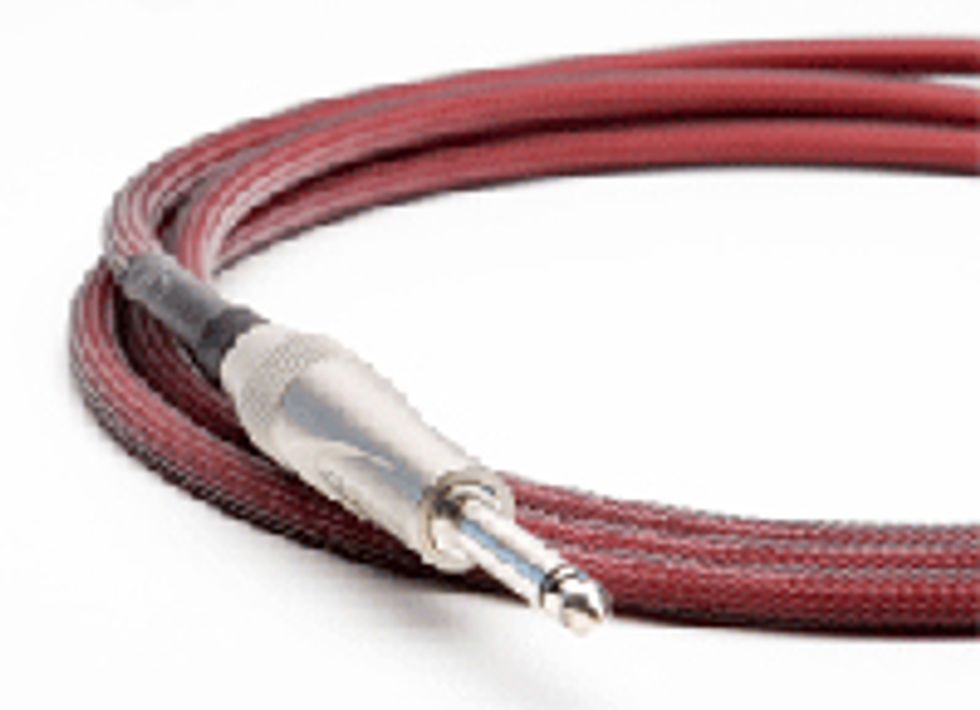
"I come from a hot-rodding background," explains Solid Cables president Nial McGaughey. So when he went in search of a super-durable jacket for his new cable design, that’s where he went – the world of race cars and aircraft, where everything has to go faster and longer without breakdown. "I kept seeing this protective armor jacket on their wiring and thought it was a perfect match for audio use," said McGaughey.
The result? A cable that’s tough, eliminating twist breakage as well as directional coiling.
Not only is McGaughey into hot-rods, but he also loves ideas from the 1950s. And that’s where he began his design of the Dynamic Arc Ultra, drawing on the classic design of a single conductor, an insulator, and a shield. From there, he added triple carbon/braid shielding. For his conductor, he sought out the purest copper he could find – aerospace quality. And to keep the cable working, the plugs are chemically welded using the same material as on dragsters and fighter jets. No nonsense, certainly!
In all, this cable was four or five years in the works. "I tried to strike a balance in playability. Extremely low capacitance cable sounds too clinical. I wanted a cable that transfers sound beautifully without coloring it." McGaughey feels he has created a cable that sounds great in multiple settings, from the music store to the stage to the recording studio.
Bob says: The low mids on this cable are very warm sounding. There is also a sweet, non-hyped top end and solid bottom. Transients were good but not particularly punchy. It seems to sound a bit more solid with the logo end plugged into the amp. The handling characteristics are good, with the unusual jacket material seemingly unkinkable. Visually, the cable gave off a very cool high-tech vibe.
Dan says: This cable has a full bottom, clear and detailed. A nice transient response, yet not brittle sounding. The jacket is a bit smaller than some, but it’s the sexiest material ever. A tiny bit stiff, but easy to manage on stage. As far as durability, the jacket is probably alligator proof. Between the potted plugs and the strain relief, this is one cable you can count on.
| Jena Labs GT Electric Guitar Cable |
| About the cable:Two high-purity, cryogenically treated copper conductors in separate cables twisted together, lifted shields on one end, fully potted thermoplastic terminations, MSRP $159 for 12’ cable. |
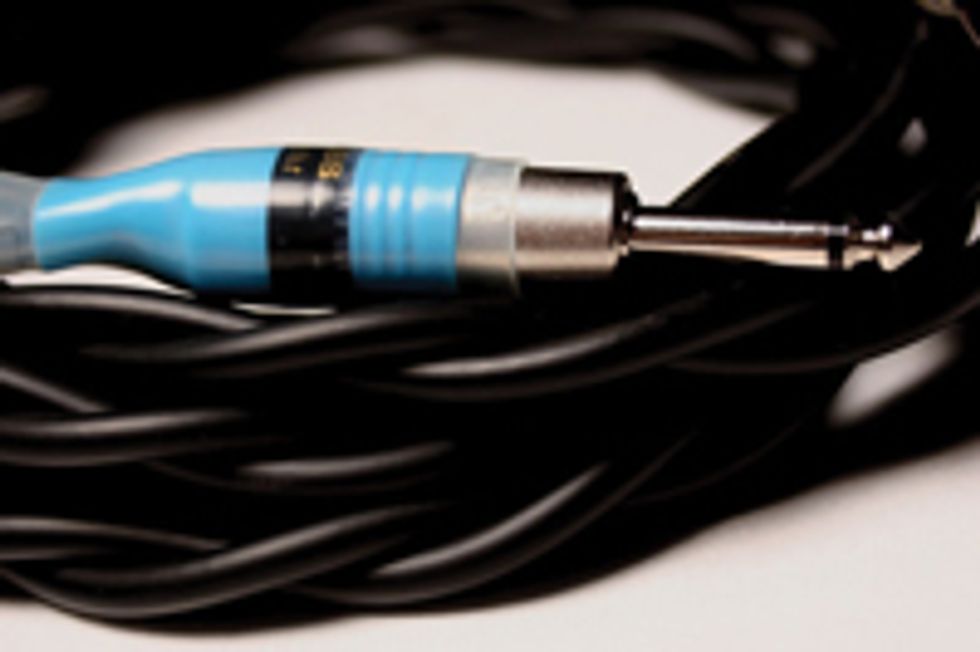 Jena Labs has a long-time reputation in the hi-fi audio world for superb cables that sell for hundreds to thousands of dollars. A trademark of Jena Labs cables is cryogenic treatment that takes cables down to -320 degrees Fahrenheit in liquid nitrogen tanks. This treatment causes metal to shrink, making the conductors to become more conductive, quieter and stronger. In essence, a cryogenically-treated cable is more nuanced, because more sound and less noise get through.
Jena Labs has a long-time reputation in the hi-fi audio world for superb cables that sell for hundreds to thousands of dollars. A trademark of Jena Labs cables is cryogenic treatment that takes cables down to -320 degrees Fahrenheit in liquid nitrogen tanks. This treatment causes metal to shrink, making the conductors to become more conductive, quieter and stronger. In essence, a cryogenically-treated cable is more nuanced, because more sound and less noise get through.
"It’s not like something new," says Jennifer White Wolf Crock of Jena Labs, where this cable has been made by special order over the last 15 years. Recently, though, Jena Labs began selling the GT Electric Guitar Cable through Rockett Pedals (rockettpedals.com).
One of the central goals of this cable is very high bandwidth, meaning that it has the potential of reproducing a wide frequency response from its signal source, such as your prize guitar. The cable is also designed for greater dynamics and better phase alignment across the audio spectrum. "The cable uses high purity copper, the best grade on the planet," Crock adds.
The late legendary jazz bassist Leroy Vinegar was one of the early users of this cable. While he valued its audio purity, he also took advantage of the sonic difference resulting from connecting the shield end to either an amplifier or an instrument. "The tone is shaped by the lowest net ground impedance. Just flip the cable end for end and you have a choice of sounds," Crock explains. And as you look at the cable, you can see that one end has a blue plug, the other a black one, just to help keep things straight. A well-known jazz guitarist also favors the GT Cable, but Crock declined to offer a name because of endorsement complications.
Along with the cryogenic conductors and the lifted shield, the thermoplastic potting in the plugs creates a very reliable connection. Sonically, this potting has a benefit, too, damping any chance of metallic resonance.
In all, this cable is one of the most unusual designs we worked with. A friend saw it and dubbed it "the umbilical cord" because of its pair of cables twisted together. But this innovation produces positive sonic results, and surprisingly, isn’t as awkward to use as it might appear.
Bob says: For guitar I much preferred to plug the blue end into the amp; giving excellent detail. The black end into the amp was a bit muddy. Transients were good and a sweet top end made for a cable that was easy to listen too. Its appearance brought to mind the DNA double helix. It was the heaviest cable per foot tested and felt unwieldy while coiling. Both ends are potted in resin, giving good support to the weight and providing strain relief.
Dan says: Great presence, yet an even, rounded top and a great bottom with the blue end on the amp. With the black end on the amp, there is greater clarity and more emphasis on the mids, yet it still sounds full. As far as handling, what can I say? It’s two cables in one, yet it’s still manageable. And I think you’d probably break your guitar before you could break the cable while playing.
| DiMarzio Steve Vai Signature Cable |
| About the cable:Copper braid and conductive PVC shield, single stranded center conductor, PVC jacket with black nylon overbraid, silver solder connections, Switchcraft gold-plated plugs with integrated PVC strain relief. MSRP $150. |
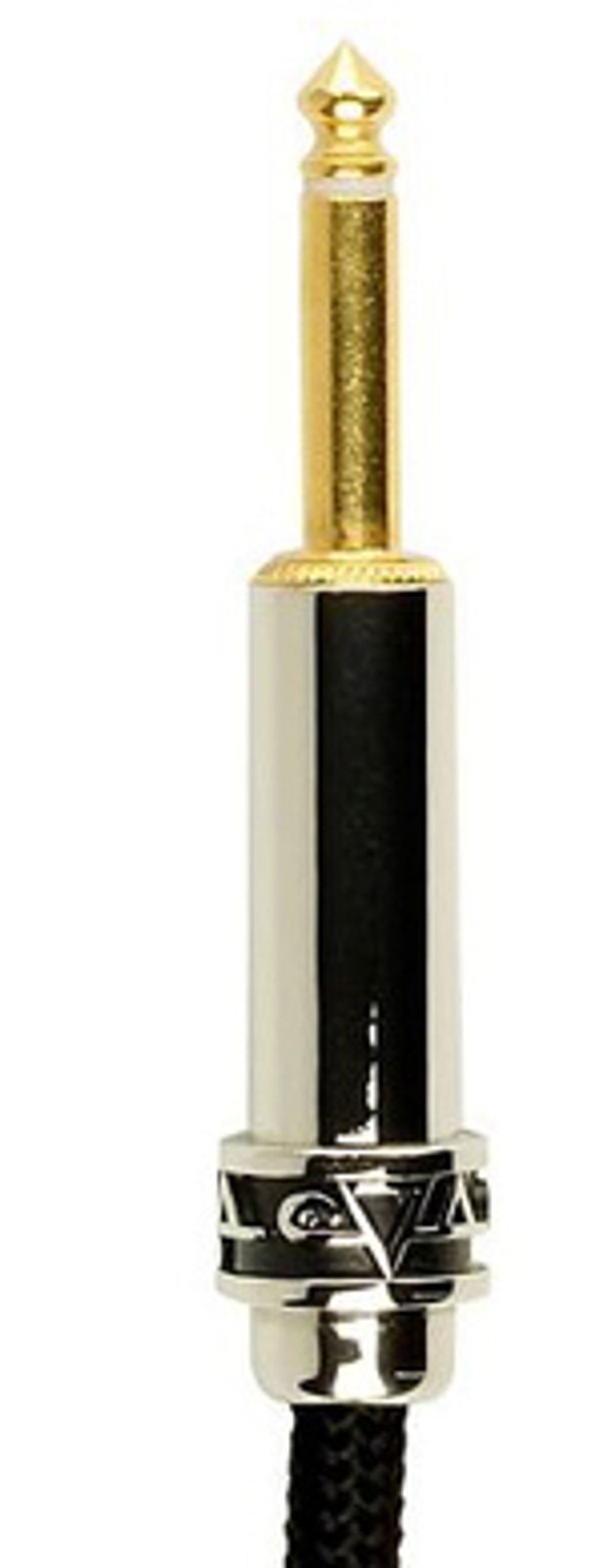 The first thing you’ll notice about this cable is its bright chrome and gold plugs with the Steve Vai logo ring on one end, set against a sleek, black cloth cable. What’s important about this cable is not its look, though, but its sonic design.
The first thing you’ll notice about this cable is its bright chrome and gold plugs with the Steve Vai logo ring on one end, set against a sleek, black cloth cable. What’s important about this cable is not its look, though, but its sonic design."I don’t believe a cable should attenuate any frequency, but a louder overall cable is better," says DiMarzio’s Steve Blucher, who has worked in R&D for the company since its early days. "Steve Vai is very precise about what he wants in frequency response. He’s a very careful listener."
Blucher explains that true frequency response was therefore important in the design of the cable. He says that Vai is one of the world’s best players at double tracking, disciplined and focused in his musical judgments. That drive for high fidelity was a key ingredient in designing this cable for Vai’s needs.
"This cable is, to my ears, pretty uncolored and efficient," Blucher asserts. He feels that any changes to a guitar’s signal should be made by a guitarist who has the whole tonal palette available to work with. Some cable designs, he acknowledges, are intentionally designed to shape the sound for a specific instrument or sound, but he has chosen to avoid that route.
"You have to know frequency response of the instruments, but guitar and bass pickups have the same frequency response so something has to be left out. And a vibrating bass string produces a hellava lot of harmonic content."
Summing up the outcome of the Steve Vai cable design, Blucher adds, "Mr. Vai seems very happy with the cable!"
Bob says: One of the least sonically hyped cables tested, its strength is in its midrange detail. I suspect this cable would be excellent in a high overdrive situation. The neutral sound made it easy to listen to. The custom plugs, complete with mystic amulet are cool, and the braided jacket has a retro vibe but seemed to contribute to increased handling noise and some difficulty with coiling. I would have liked to see more strain relief.
Dan says: This cable is sonically in the middle ground, not overly bright or deep. Slightly less punch than some others we’ve tested, but sounds nice in the mids. It’s a slightly thinner cable, a bit stiff and coily. There’s a nice feel to the black braided cloth jacket. The strain relief is something different, using a plastic fitting right at the plug without any heat shrink. I always like some heat shrink with traditional plugs like the Switchcraft plugs this cable uses.
| Elixir Cable |
| About the cable:Alloy center conductor, 95% coverage braided shield, patent-pending insulation, proprietary plug design with gold-plated sleeve and tip. MSRP $69.95 for 20’ cable. |
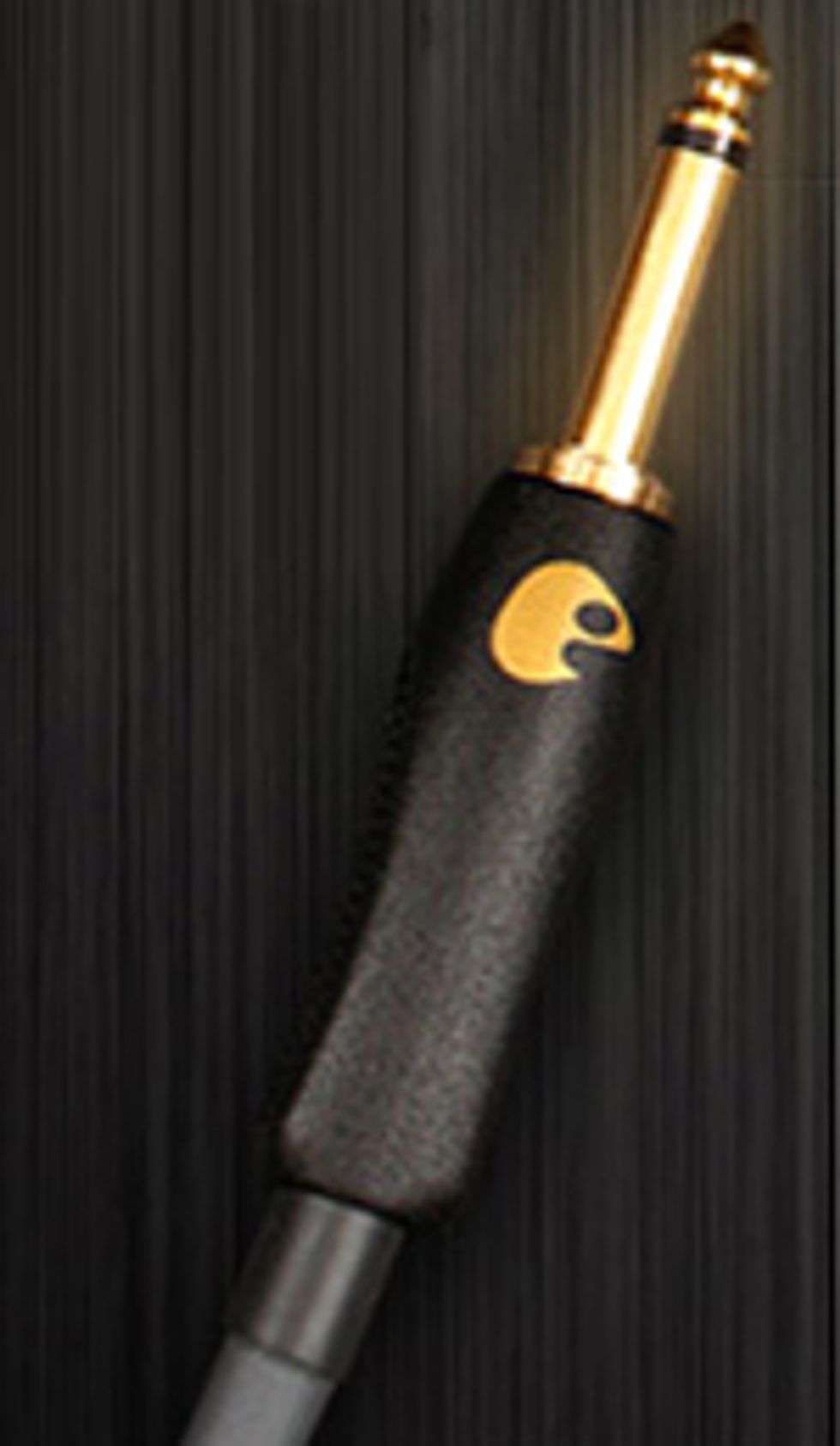 W. L. Gore, Elixir’s parent company, has about 50 years of experience in designing cables for critical telecommunication purposes. So when Elixir decided to create a guitar cable, they asked the Gore folks to bring out their test equipment.
W. L. Gore, Elixir’s parent company, has about 50 years of experience in designing cables for critical telecommunication purposes. So when Elixir decided to create a guitar cable, they asked the Gore folks to bring out their test equipment.A starting premise for this cable’s design was that the inductance of a pickup combines with the capacitance of a cable to create a guitar signal’s frequency response and decay. "We asked them to sample and model a pickup and cable so we could see what was happening," says Craig Theorin, product manager at Elixir.
What they discovered was that a typical Strat pickup has a peak response at 4 khz and rolls off 3db by 6.5 khz. And that’s with a 3’ cable of typical capacitance. Their testing further discovered that a typical 20’ cable peaks at 2 khz and goes down 3 db by 3.5 khz.
Elixir’s goal, then, was to create a 20’ cable that would produce a frequency response similar to that of the 3’ cable.
"I can’t share a lot of the design details, because we’ve applied for a patent, but I can say that we use a high strength alloy conductor rather than plain copper," Theorin explained. "And to get the capacitance down, you need to build a lot of air into the dielectric." This design consideration adds more separation between the shield and the cable’s center, making for a thicker cable.
In all, Theorin believes his sonic design goal was achieved while also making the cable’s price reasonable. "We don’t want to be a premium cable that you can’t find in stores," he adds.
Bob says: A bright cable with good sustain and detail which gives it an aura of transparency. Attack transients and dynamics were good. Not as punchy as some but well balanced and easy to listen to. The cable handled a bit stiffly but coiled okay. I didn’t care for the non serviceable proprietary plugs, but of course this helps protect the secret of the structure. Maybe once the patents are received we will see more easily serviced plugs with better strain relief.
Dan says: This cable has nice detail, clear and even sounding response across the spectrum, with a full bottom. It’s a thicker cable, but flexible and relaxed – maybe a little toward the heavy side. The proprietary plugs seem sturdy and the heat-shrink strain relief is okay, but could be a bit longer. I think this cable will be a survivor.
| Mogami Platinum |
| About the cable:$145 for 20'' cable at select Guitar Centers |
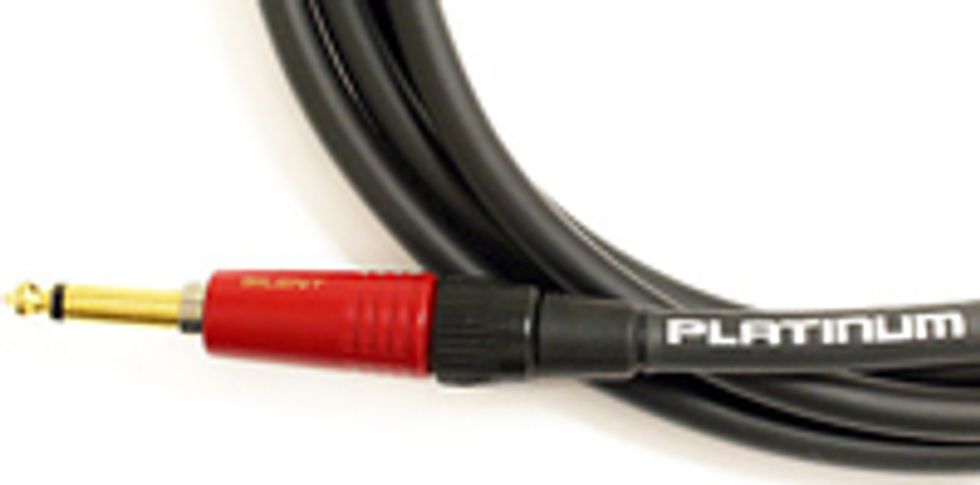 The first thing that Phil Tennison of Marshall Electronics (distributor of Mogami) mentioned is that the cable does not contain any Platinum. It just signifies that it is a step up in quality (and price) from their "Gold Series".
The first thing that Phil Tennison of Marshall Electronics (distributor of Mogami) mentioned is that the cable does not contain any Platinum. It just signifies that it is a step up in quality (and price) from their "Gold Series".The step up in quality and sound has a lot to do with a step down in Capacitance of the cable.
The new cable features Mogami’s fine-stranded 20 ga center conductor now surrounded by a fairly thick foamed, high dielectric poly insulator, which is in turn surrounded by a double spiral wrap of fine copper shielding and a lead-free poly jacket.
Mogami believes in trying to optimize the overall sound intended by the pickup designer without revealing frequency anomalies often found in some other high end cables.
In Phil’s words: "I would definitely clarify that I don’t think revealing is the right concept, but that the designers are expecting a specific range of electrical load on the pickup. If it is too far off the mark, the frequency response will be messed up."
The Platinum is terminated by Neutrik connectors, with the instrument end utilizing their cleverly designed "Silent Plug," which silences the signal automatically when the plug is removed and reinstates it immediately and automatically when it is plugged into the instrument
Bob says: This cable sounds good enough to eat. With its ample tight bottom, muscular mids, and sweet voluptuous highs… well, you get the picture. It has great dynamics and punch as well. It is somewhat thick and heavy, possibly due to the extra layer of spiral wrap shielding, but is flexible and handles well.
Dan says: Great detail, with a high-mid emphasis and excellent transients. Really a clear-sounding cable that should be nice for slappers. It’s a bit heavier and thicker than some, but still flexible and relaxed. The Neutrik silent plug is a nice touch, letting you change axes without any buzzing. The built-in strain relief in these plugs makes for a sturdy cable.
| Alleva~Coppolo Artist Cable |
| About the cable:Sold directly through Alleva~Coppolo. Call for pricing. |
Jimmy Coppolo is a renowned guitar and bass maker located in New York (though he''s relocating to California soon). He designed his cable to optimize the sound of his instruments when played through high quality amplification. He has been working for several years with a cable designer/manufacturer in the U.S. to get it just right and prefers to keep the details of design in house.
Bob says: The Alleva~Coppolo exhibited excellent tonal balance with a slightly hyped, but sweet high end. There was excellent detail. Both natural and artificial harmonics came through nicely and there was good sustain.
Dan says: Excellent definition, both in the transients and the high end. Good bottom, too. This should make an excellent bass cable for muddy rooms. It made my Jazz bass bark. The cable design is a bit thinner than some, yet somewhat stiffer than expected – probably because of the 95 percent shield. The single heat shrink under the G&H plugs could be a bit longer, but it does the job.
| Klotz |
| About the cables:The slim profile of the La Grange guitar cable and the even slimmer T.M. Stevens "Funkmaster" Signature cable belie the underlying sophistication of the cable design. There are six layers to these cables: an inner core of stranded copper is surrounded by insulation. This inner insulation layer is surrounded by the key ingredient in the design, which is a white conductive plastic layer that is not terminated at either end. That conductive plastic is in turn surrounded by another layer of insulation which separates it from the spiral copper shield; it is all held together by a rubber jacket. |
Kendrick Amplifiers provided two cables, both manufactured by Klotz in Germany, a very large cable company making a wide variety of cables for the European pro audio market. Kendrick is the US distributor and vendor.
Gerald Weber, master of vintage sound and head of Kendrick Amps sums up the theory behind the cable design:
"The German engineers at Klotz have rethought guitar cable design. Instead of using the standard ‘center conductor/insulation/shielding’ scenario, which is used by virtually all other cable manufacturers, Klotz adds a conductive plastic material in between the center conductor and the copper shielding. Of course, this conductive plastic is insulated on both sides from the conductors (center conductor and the shielding). The conductive plastic is not connected to anything electrically, so it is not a path to ground. The electrons on the copper shielding cannot "see" the center conductor through the conductive plastic shielding and the electrons on the center conductor cannot "see" the copper shielding through the conductive plastic shielding, so the electrons are forced to go all the way to the amplifier''s input rather than "jumping ship" across the cable. How does this affect tone? The signal getting to the amp is the same signal that came from the guitar, resulting in noticeably longer sustain, more focus, and better clarity. The clarity is particularly noticeable when playing close voicings, such as a major 7th or a minor 9th. But most of all, it lacks the filtered sound found in other cables."
The LaGrange is terminated by premium Neutrik plugs and the "Funkmaster" by custom spun anodized gold aluminum connectors that would look just right with that silver lame jump suit you’ve been just dying to wear, but didn’t have the proper accessories.
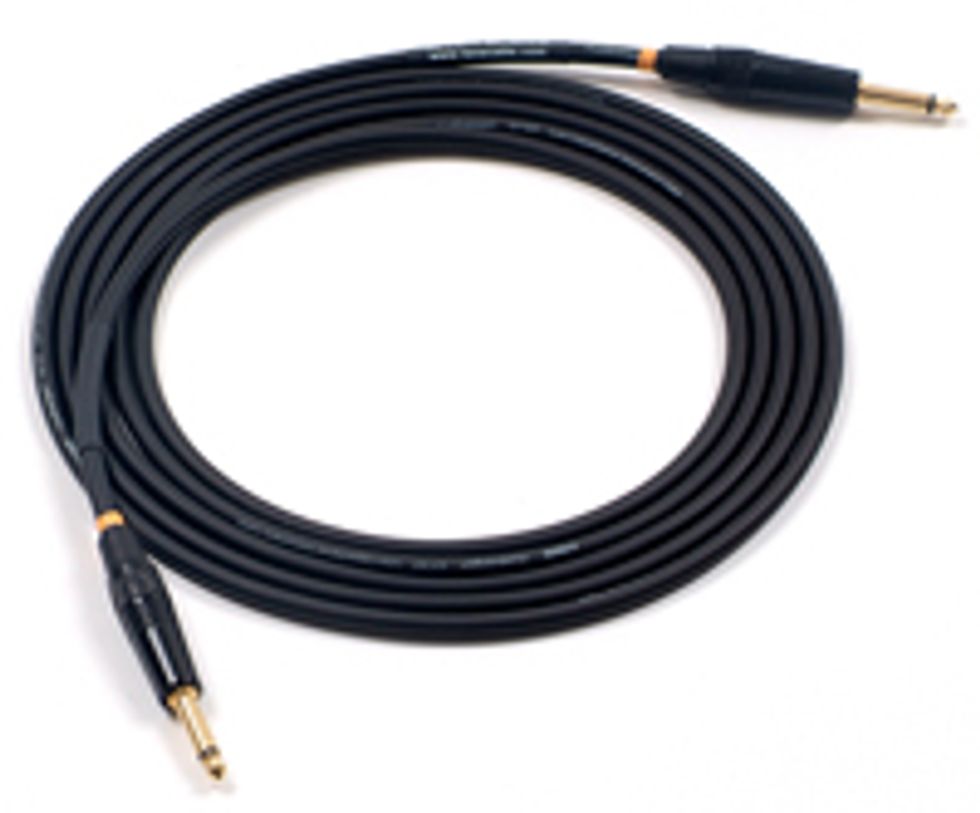
LaGrange ($89.99 for 20'')
Bob says: The LaGrange was loud and punchy, with a full range guitar spectrum that was well balanced. The mids were well-detailed and highs very present without being strident. Good picking attack transients combined with excellent sustain. Definitely a cable I could listen to for hours.
Dan says: The LaGrange has a big bottom and clear top, nicely detailed with super transient response. The traditional diameter cable is a bit stiff and coily, but not really a problem. The built-in strain relief of the Neutrik plugs should help this cable last a long time.
T.M. Stevens "Funkmaster" ($88.99 for 20’)
Bob says: The "Funkmaster" is designed primarily for bass but is a pretty nice sounding guitar cable. I sort of nicknamed it the "smile" cable because it had strong lows and highs, with the mids sounding a bit attenuated. Both cables handled very well in their rubber jackets, with the thinner Funkmaster getting the nod for flexibility. Both are well made and should hold up well under duress.
Dan says: The "Funkmaster" has a warm but clear top with good detail and transient response and a bit of midrange emphasis. It has a typical cable diameter with good flexibility. Its unusual orange aluminum plugs have heat shrink over the connections, plus an unusual spring strain relief. Should be a sturdy cable that brings home the funk.
| Zaolla Sliverline Cables |
| About the cables:Zaolla cables are distributed by Hosa Technology and use hi-tech coax design combined with unique material choice: a solid silver center conductor. The cable itself has nine, yes nine separate layers. That’s a lot of jam in that jelly roll. |
The core conductor of the cable is 20 ga pure silver wire; with an emphasis on the pure. More on that later. That core is encased in a high dielectric insulator which is in turn wrapped with enameled copper wire. The copper and the silver are connected on both ends at the tip of the plug. The next layer is an FPE precision foam high dielectric insulator which is encased in a conductive PVC shield which is then surrounded by a braided oxygen-free copper braid. There is then a surround of Teflon lubricated paper to provide some slippage between the conduction core and the jacket, which has two layers of PVC.
In other words there are redundant center connectors and shields.
The cable is terminated by premium grade G&H connectors. In the Artist series, the cable is sent to G&H and the connections are crimped by a proprietary pneumatic process which provides solder-free contact. In the Standard series, the plugs are soldered at the factory using high silver content solder.
The only difference between the standard series and the Artist series is the method of attachment of the plug.
There is no dispute that silver is a more efficient conductor. However, there have been some concerns about its durability. Rob Manning of Zaolla has assured us that there is a very large difference in the durability of alloyed silver used in other applications and the pure silver used by Zaolla, with the pure being far tougher. In fact, Rob states, "We never had a cable returned because of breakage." He says there had been some problems with the plug previously used on their cables, but absolutely no problem since switching to the G&H premium plugs. A trip to the G&H website demonstrated to me exactly how well these plugs are built.
Silverline Artist (MSRP $178 for 20'')
Bob says: I found this cable to be very revealing of tones not heard previously from my Tom Anderson. The top is very bright and uncovered a certain brittleness in the very high overtones. The midrange sprang from the speaker cone with super detail and the lows were full and weighty. Transients were handled well with a bit of extra sparkle. All of this detail and top end detracted a bit from single note punch and chords came through as overly bright. I was able to compensate with EQ adjustment; but this just shows how much more signal is present in this cable than the average. Oh, yeah, this cable is loud. Considering how much "stuff" is built into this little gray snake it was agreeably flexible, but a bit on the heavy side.
Dan says: A bit thicker sound than the standard version, this cable seems to have great bandwidth, detail and transparency. As with the standard model, it’s a thicker cable, a little stiffer and heavier than many.
Silverline Standard (MSRP $155 for 20'')
Bob says: This is the exact same cable as the Artist except for the soldered connectors. It sounded the same except that it was not quite as bright. I found this cable much easier to listen to with my reference settings. If you have a guitar with an "ice pick" bridge pickup, this might balance things out a bit better.
Dan says: A bit rounder sounding top end, with a liquidy tone on the Jazz and an even low end, although not overly deep. Well-defined sound without being harsh. As might be expected from this cable’s construction, it’s a thicker cable, a bit stiff, coily, and heavy. They’ve made this one with a nice heat shrink over the top of the plug. I wonder about the durability of a solid center conductor, but that should be taken care of by the thicker jacket and stiffer design.
| Evidence Lyric HG |
| About the cable:Twin 20 ga solid copper signal conductors of extra high grade copper surrounded individually by conductive carbon wrap provides the core which is then insulated from the braided copper shield by a high dielectric foamed poly. All is surrounded by a two-color woven nylon jacket and terminated by premium Neutrik connectors. $155 for 20'', distributed by Audionova. |
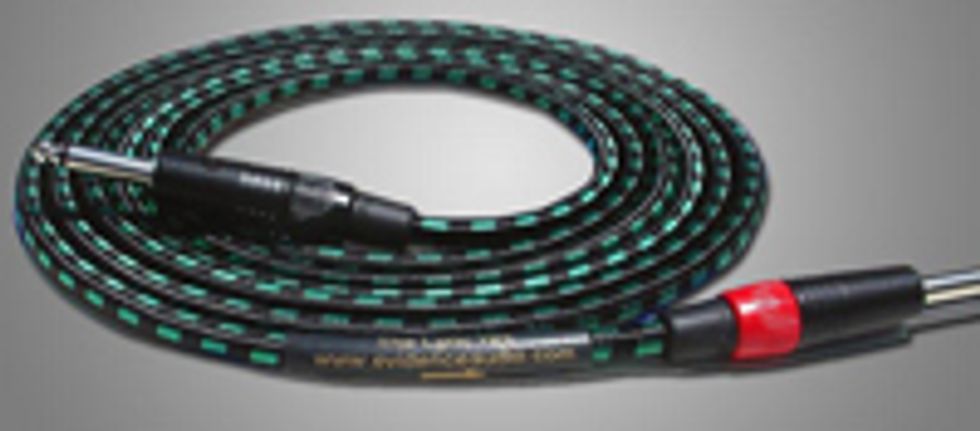 Tony Farinella at Evidence Audio has been perfecting his cables for over 20 years. Cable designers and builders all have a somewhat different take on what constitutes an ideal cable.
Tony Farinella at Evidence Audio has been perfecting his cables for over 20 years. Cable designers and builders all have a somewhat different take on what constitutes an ideal cable.Tony states that if he could build a perfect cable it would have absolutely no effect on the sound emanating from the output of the source device, and that has been his design goal over these many years. To accomplish this, he relies on premium solid copper conductors in 20 gauge size, which he feels is compulsory for unimpeded signal flow. The conductive carbon wrap around each conductor reduces microphonics in high gain situations. The high air content of the foamed poly insulator greatly reduces cable capacitance. The high density braided copper shield does not carry signal; that task being the sole responsibility of the conductor pair; one carrying the hot side and the other the return side.
Tony is the first to admit that the necessary components of this cable add up to it being rather stiff.
An interesting aside is that this same cable is terminated with XLR connectors and sold as a microphone cable for studio use, where it has developed a devoted following of well-known engineers. Now, that is saying something about signal quality.
The cable specs out with a bandwidth of 20-20k Hz. With this kind of bandwidth, the Lyric HG is ready for any complexity of signal thrown at it and will handle it with ease, adding no coloration of its own.
Very open mindedly Tony recognizes the validity of other cable design philosophies and realizes that a very revealing cable is not for everyone, saying, "I would prefer that no one purchase anything without listening to it."
Bob says: The Lyric HG cable was very open sounding with an extended high end that I had heard somewhat on the Silverline Artist. The extended top was combined with a smooth bottom and a detailed mid to give the Anderson mini-buckers a rather clinical sound. I did miss the punch of a couple of the other cables, but good dynamics helped make up for that.
Trying to coil this 20 footer was like wrestling with a live snake, and if I were to use one for gigging I would probably go for a shorter length. Tony also mentioned that the cable tended to loosen up with time. I’m not sure if that is good or bad, as the solid conductors already would tend to have a shorter service life. A fine sounding cable especially for studio and complicated stage rigs.
Dan says: This cable has one of the brighter top ends we’ve heard, extra transparent. It has nice bandwidth and transient response, with superb focus on the lower end. However, this is the stiffest cable I’ve tested, which isn’t a surprise given the two solid inner conductors. The nice braided cloth jacket is somewhat coily on the floor. The Neutrik plug provide great strain relief.
| For more, listen to our podcast |
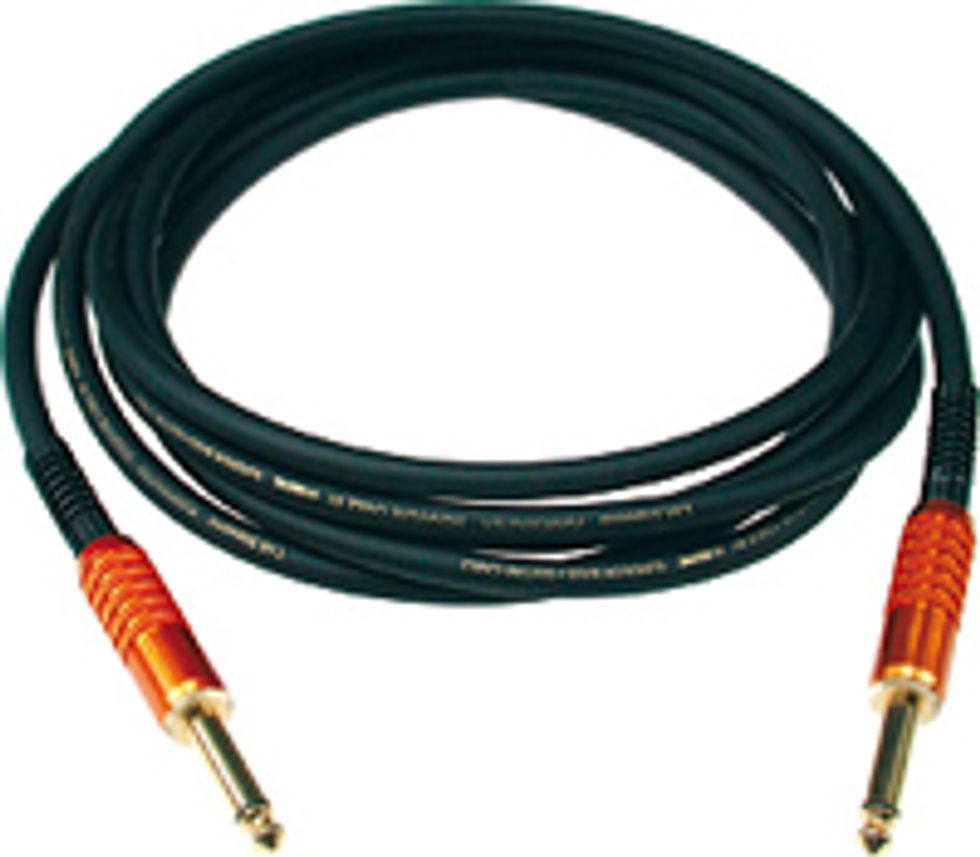 T.M. Stevens "Funkmaster" ($88.99 for 20’)
T.M. Stevens "Funkmaster" ($88.99 for 20’)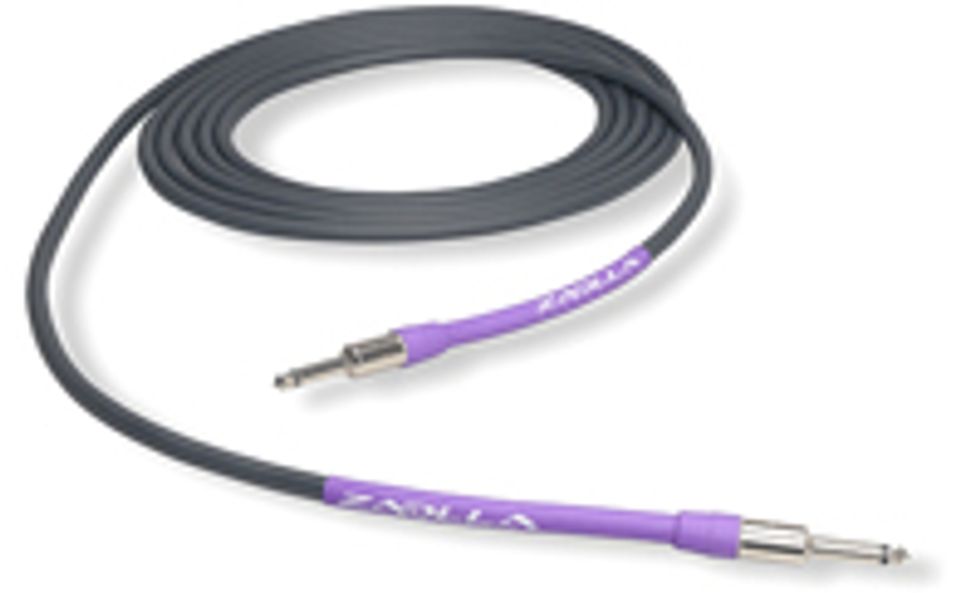 Silverline Artist (MSRP $178 for 20'')
Silverline Artist (MSRP $178 for 20'')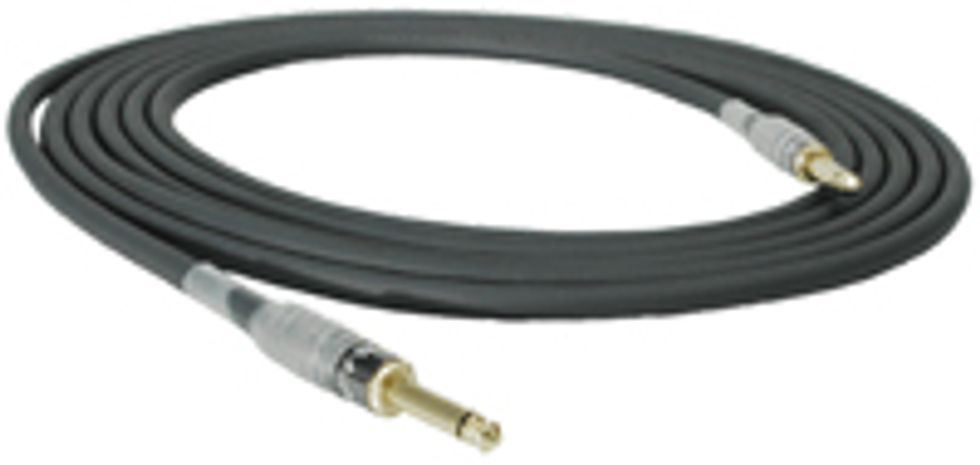 Silverline Standard (MSRP $155 for 20'')
Silverline Standard (MSRP $155 for 20'')